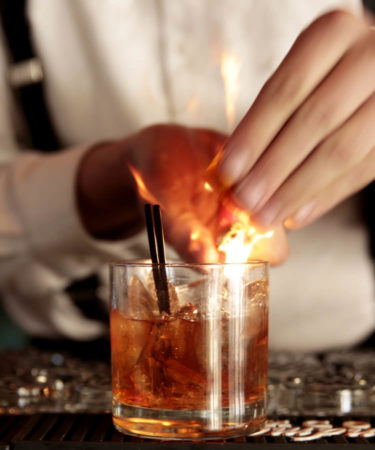Got a question? Email [email protected].
Why do some bartenders light citrus peels on fire, and which side are you supposed to light?
You might think a bartender is simply flaming citrus to show off, but that’s only part of the reason it’s done. Flamed citrus adds wow factor, yes, but it also helps accentuate the flavor of the peel, bringing out the bright, citrusy notes in the oils just before you add it to the drink.
If you want to try it at home, oranges work best, but any citrus will do. Just light the outside of the rind on fire, not the inside where you find the bitter, white pith. Here’s a step-by-step guide:
- Grab fresh citrus, a peeler, and some matches or a lighter.
- Peel off a good chunk of the peel, trying to get as little of the pith as possible.
- Hold the flame a few inches above the drink.
- Squeeze the peel with outside facing away from you in the direction of the flame, toward the drink. Squeeze it hard to get out as much juice and oil as possible in one fell swoop. The flame should “pop” and the citrus oils will fall into the drink.
- Garnish the drink with the peel and enjoy.
What wine has the highest/lowest alcohol?
The wine with the lowest alcohol is often Moscato d’Asti from the northern region of Piedmont in Italy. This light, effervescent wine can be found with as low as 5.5 percent alcohol, around the same percentage as a Budweiser. The highest, on the other hand, not counting dessert wines, are usually California Zinfandels, which can clock in at well over 16 percent ABV.
Does New England IPA have to be made in New England?
Juicy, fruity, and floral IPAs may have been invented in New England, but the popular style can be made anywhere and still be called a New England IPA — just like how West Coast-style IPAs can also be made on the East Coast.
